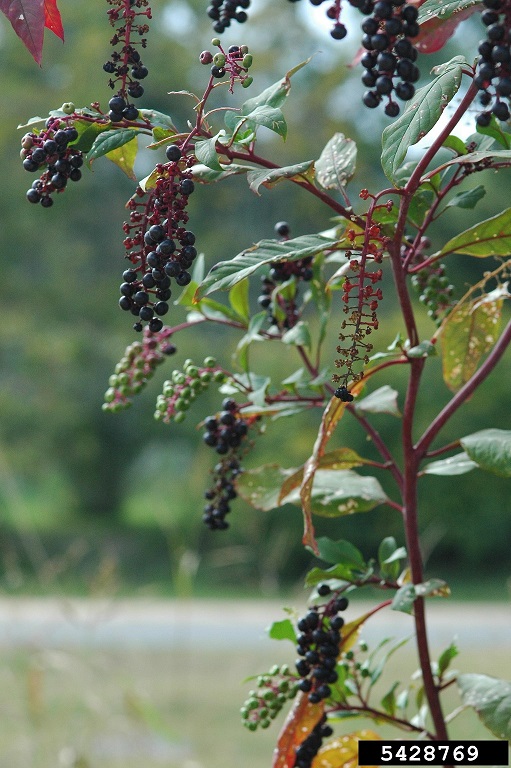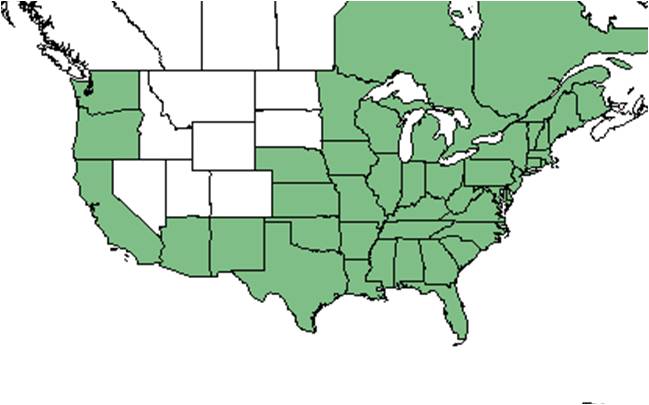Phytolacca americana
| Phytolacca americana | |
|---|---|

| |
| Photo by Karan A. Rawlins, University of Georgia, Bugwood.org | |
| Scientific classification | |
| Kingdom: | Plantae |
| Division: | Magnoliophyta - Flowering plants |
| Class: | Magnoliopsida – Dicotyledons |
| Order: | Caryophyllales |
| Family: | Phytolaccaceae |
| Genus: | Phytolacca |
| Species: | P. americana |
| Binomial name | |
| Phytolacca americana L. | |

| |
| Natural range of Phytolacca americana from USDA NRCS Plants Database. | |
Common names: American pokeweed; Common pokeweed; Poke; Pokeberry[1]
Contents
Taxonomic notes
Synonyms: none.[1]
Description
A description of Phytolacca americana is provided in The Flora of North America. It is a robust, perennial herb that grows 1-3 m tall. The roots are thick and fleshy. The leaves have an alternate pattern, glabrous texture, entire margin, and lanceolate to elliptic shape. They grow 3-12 cm wide and 8-30 cm long with a rounded base. The petioles are 1-5 cm long. Racemes are 5-20 cm with bracteate pedicels. The flowers are perfect, colored green to white, and 2-3 mm long. They include 5 sepals, 5-30 stamens, and a superior ovary. The berries are 5-12 carpellate, purplish-black, 4-6 mm long, and 7-10 mm in diameter. The seeds are lustrous black, 2.5-3 mm long, and flattened.[1]
Distribution
This plant is an abundant native weed that occurs throughout eastern North America.[1]
Ecology
Habitat
P. americana has been found in hydric hammocks, swamp edges, coral limestone, sandbars, mangrove swamps, and floodplain forests.[2] It is also found in disturbed areas including disturbed coastal hammocks, along canals, farmlands, orange groves, landfills, burned longleaf pine-wiregrass flatwoods, pine-hickory camping woods, and along roadsides.[2] Associated species: Sabal, Quercus, Elaphrium, Swietenia, Dalbergia, Gouania, and Schinus.[2]
Phenology
This plant has been observed to flower from March through November, with peak inflorescence in May through July.[1][3]
Pollination
The following Hymenoptera families and species were observed visiting flowers of Phytolacca americana at Archbold Biological Station:[4]
Apidae: Bombus impatiens
Halictidae: Augochlora pura, Augochlorella striata, Augochloropsis metallica, A. sumptuosa, Lasioglossum lepidii, L. miniatulus, L. nymphalis, L. pectoralis, L. placidensis, L. puteulanum
Megachilidae: Heriades leavitti
Sphecidae: Ectemnius maculosus, E. rufipes ais, Isodontia exornata, Oxybelus laetus fulvipes
Vespidae: Leptochilus alcolhuus, L. republicanus, Polistes dorsalis hunteri, Zethus slossonae
Conservation, cultivation, and restoration
Cultural use
Historically, the roots and berry juice was used by native peoples to treat skin cancers, diseases, swelling, and injuries.[5] The root can be extremely toxic and act as a narcotic, emetic, and cathartic if ingested in too large of doses.[6]
People in Appalachia would eat and can the immature leaves of the pokeberry plant[7], and the young shoots can be used an asparagus or spinach substitute. Care must be taken not to harvest mature plants because the bark will be toxic. The berries can also be used as a food coloring in frosting and candy.[8]
Photo Gallery
References and notes
- ↑ 1.0 1.1 1.2 1.3 1.4 1.5 1.6 Weakley, A.S. 2015. Flora of the southern and mid-atlantic states. Working Draft of 21 May 2015. University of North Carolina at Chapel Hill, Chapel Hill, North Carolina.
- ↑ 2.0 2.1 2.2 Florida State University Herbarium Database. URL: http://herbarium.bio.fsu.edu. Last accessed: June 2021. Collectors: Loran C. Anderson, George R. Cooley, R. J. Eaton, D. L. Fichtner, Robert K. Godfrey, B. K. Holst, O. Lakela, S. W. Leonard, Marc Minno, Grady W. Reinert, Cecil R Slaughter, S. D. Todd, and Jean W. Wooten. States and counties: Florida: Hernando, Indian River, Jefferson, Leon, Liberty, Manatee, Monroe, Okaloosa, Orange, and Sarasota.
- ↑ Nelson, G. PanFlora: Plant data for the eastern United States with emphasis on the Southeastern Coastal Plains, Florida, and the Florida Panhandle. www.gilnelson.com/PanFlora/ Accessed: 19 MAY 2021
- ↑ Deyrup, M.A. and N.D. 2015. Database of observations of Hymenoptera visitations to flowers of plants on Archbold Biological Station, Florida, USA.
- ↑ Korchmal, Arnold & Connie. 1973. A Guide to the Medicinal Plants of the United States. The New York Times Book Company, New York.
- ↑ Fernald, et al. 1958. Edible Plants of Eastern North America. Harper and Row Publishers, New York.
- ↑ Korchmal, Arnold & Connie. 1973. A Guide to the Medicinal Plants of the United States. The New York Times Book Company, New York.
- ↑ Fernald, et al. 1958. Edible Plants of Eastern North America. Harper and Row Publishers, New York.